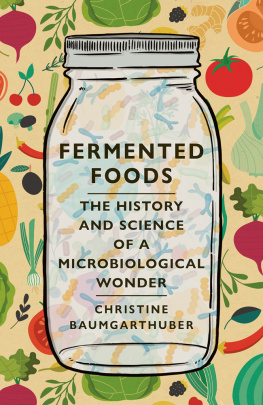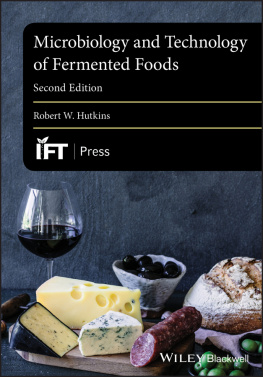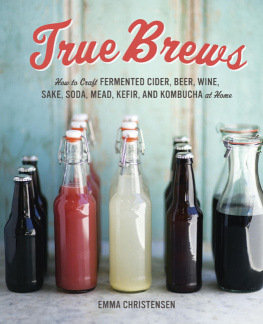Fermented Foods

Fermented Foods
The History and Science
of a Microbiological Wonder
CHRISTINE BAUMGARTHUBER
REAKTION BOOKS
For E.B.M. and H.P.L.
Published by
REAKTION BOOKS LTD
Unit 32, Waterside
4448 Wharf Road
London N1 7UX, UK
www.reaktionbooks.co.uk
First published 2021
Copyright Christine Baumgarthuber 2021
All rights reserved
No part of this publication may be reproduced, stored in a retrieval
system or transmitted, in any form or by any means, electronic,
mechanical, photocopying, recording or otherwise, without the prior
permission of the publishers
Page references in the Photo Acknowledgements and Index match the printed edition of this book
Printed and bound in Great Britain
by TJ Books Ltd, Padstow, Cornwall
A catalogue record for this book is available from
the British Library
eISBN 978 1 78914 376 8
Contents
Introduction
Faithful Friends and Implacable Foes:
The Nature and History of Our Relationship to Microbes
1 Laughter and Wild Play:
The Birth and Evolution of Fermented Drink
2 Un Grand Progrs:
The Industrialization of Fermented Drink
3 Oven Worship:
Bread and Its Various Preparations from Earliest Antiquity to the Present
4 A Sometimes Dicey Duality:
Fungi and Food
5 One of the Miracles of Everyday Life:
The Origins, Power and Fortunes of Vegetable Ferments
6 Microbes Working Their Magic:
Cheese, Yoghurt and Other Dairy Ferments
7 Tasty but Dangerous:
The Virtues and Risks of Sausage and Fermented Meats
8 A Different Relationship to Nourishment:
Fermented Foods Present and Future
Introduction
Faithful Friends and
Implacable Foes:
The Nature and History of
Our Relationship to Microbes
The versatile character of the microbe is strikingly revealed in the contemplation of the kaleidoscopic mosaic of life.
Arthur Isaac Kendall, Civilization and the Microbe (1923)
IN THE SPRING OF 2007, I received a small envelope containing a sourdough starter born on the Oregon Trail, a survival of American pioneers push westward. The starter could not have been more unprepossessing. It looked like dust and left me wondering whether I had erred in ordering it. I nevertheless mixed it with flour and spring water in a Mason jar and went to bed, only to wake to a bubbling goo that covered the countertop. As I cleaned up the mess it came home to me how much livelier than store-bought dried yeast this heirloom starter was.
The starter had a personality, and a finicky one at that. It sulked when I left it unused in the refrigerator too long. And it sulked even more when I forced on it rice flour and tapioca during a gluten-free diet lark I went on for a few months. Really, even keeping the thermostat too low in winter put it out of temper. Its spirits would rise with the arrival of spring. The warmer days set it enthusiastically digesting the organic rye flour I fed it, and it would reward my care with perfect loaves of crispy French bread, airy ciabatta and dense rounds of sour rye.
My success with it inspired me to attempt other ferments. For guidance I turned to Sandor Ellix Katzs seminal Wild Fermentation and my family of ferments came to include, at various times, kefir, kombucha, lactic-acid-fermented cucumbers, beetroot and peppers, as well as tibicos (a fermented drink popular in Mexico), cider and even red wine.
Each evening I tended my ferments, the ritual anchoring me in what I saw as an increasingly tumultuous world. Financial markets might have been crashing along with my prospects of a steady job, but I could care for my ferments, each one a world in itself, and I would be rewarded with health and a hobby. George Orwell thought taking tea to be a mainstay of civilization. For me it was brewing tea for another batch of kombucha.
I suspect my motivation for taking up fermenting differed little from urges felt by others who take up keeping chickens, putting up preserves and similar urban homesteading pursuits. I sought connection to a sweep of time vaster than my own moment. For ages ordinary people have brewed beer, ripened cheese, baked bread and cured meats in times of war and of peace, of plenty and of want. Only quite recently in history has the art come to be seen as arcane, even dicey.
I have been told home fermenting is a waste of time. I have also been told that I will probably poison myself. These dismissive if not distrustful remarks led me to ask why it is that do-it-yourself fermenting no longer seems to enjoy the same aura of cosy self-sufficiency as, say, baking pies from scratch. The answer, I was to discover, is an important part of this history of fermented foods. As it turns out, suspicion of fermented foods owes to a peculiar blend of scientific and market forces so influential as to sway consumer preference in the direction of bland, unappetizing mass-produced substitutes for the zestier originals we can and did make ourselves. Fermented foods reflect humanitys relationship to a second domain of life both invisible and ubiquitous. Their history is a history of how we came to learn that bacteria and fungi are our friends and foes, variously. The danger we imagine homemade sauerkraut or sausage to pose, then, rests on our awareness of how fell an unseen enemy can be and did indeed prove to be one fateful Scottish summer nearly a century ago.
***
August 1922 saw the death of eight visitors to a hotel in the remote western Scottish Highlands known for its romantic scenery and excellent management. None of the eight appeared frail or unwell. On 14 August they had gone on an excursion planned for them by the hotel staff. That morning each went his own way some to fish, others to mountaineer before convening on the shore of nearby Loch Maree for a lunch of sandwiches of pts of wild duck, ham and beef tongue, along with jam, butter, hard-boiled eggs, scones and cake. Everyone in the party returned to the hotel in time for dinner.
The next morning a guest who went on the excursion, one Mr S., began vomiting. By the evening of that day he had died.
Another guest, one Mr W., fared little better. Dizzy when he woke, he staggered when he tried to walk and complained of double vision. He summoned a doctor, to whom he apologized for having put him to any trouble. Then, feeling somewhat better, he went to breakfast. The next morning found him paralysed, and by the evening of that same day he, too, had died.
Also suffering from double vision was Mr T., at 22 years old the youngest victim. Though his symptoms were mild early on, by the morning of 16 August he could no longer speak and was dead by the afternoon.
Mr D. likewise woke to dizziness and double vision on the morning of 15 August. Rather than take to bed, however, he boarded his boat. He rowed four miles, remarking to his boatman at one point that he would see two fish for every one that would appear. The following day saw him neither better nor worse, save that his double vision had gone. The next day it was back, and his speech was slurred as well. Things continued this way for two more days. On Sunday 20 August, paralysis gripped him. Death claimed him by noon of the following day.
The four other guests similarly died following bouts of dizziness, double vision and finally paralysis. Physicians present suspected food poisoning. But of what kind? Because the toxin claimed two boatmen, they must have dined at some point with the remaining victims, all hotel guests. While they could still manage, several victims had mentioned the excursion and its al fresco luncheon. Suspicion fell on the duck pt.






